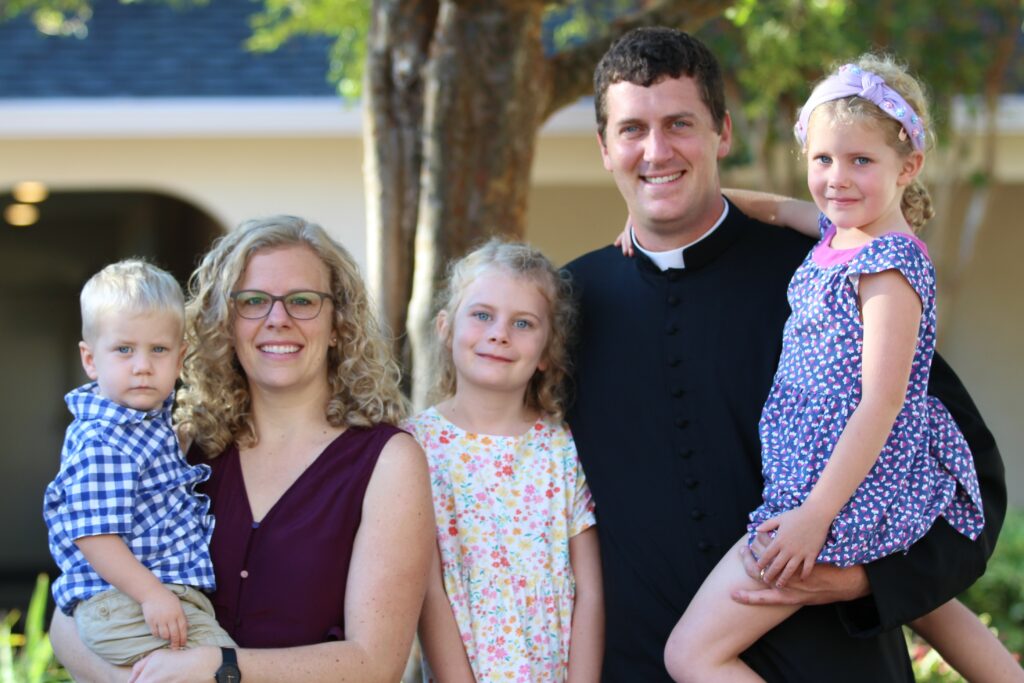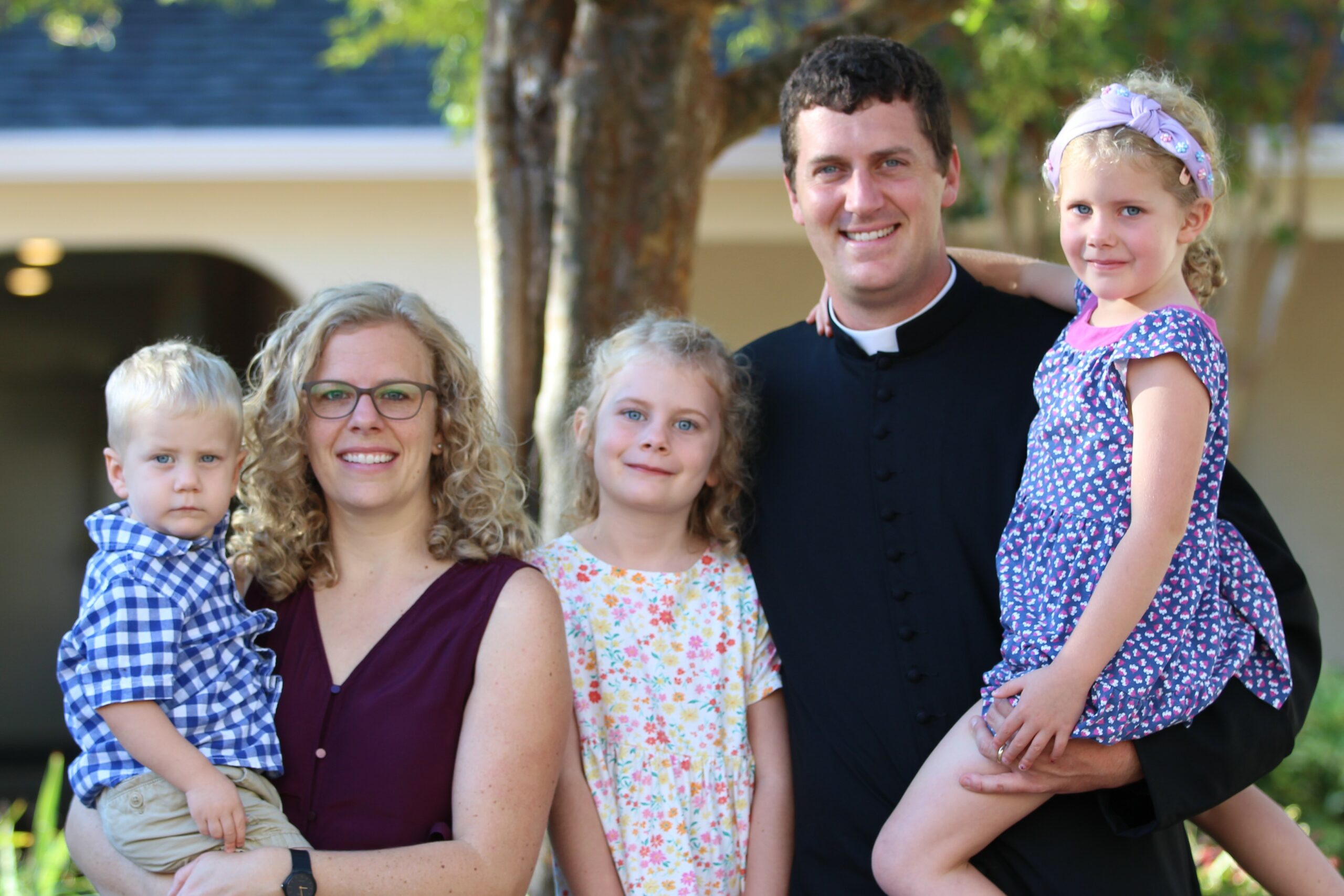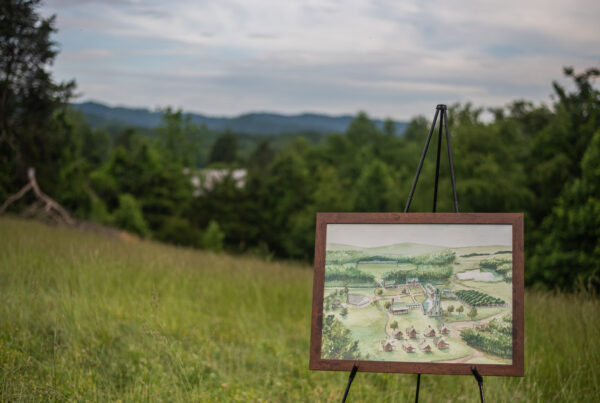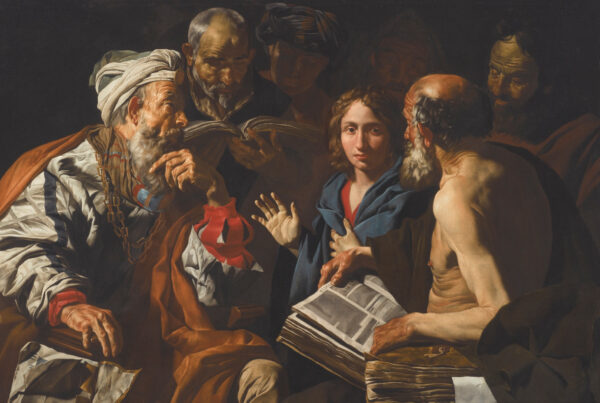St. Dunstan’s Academy has hired Fr. Mark Perkins as Chaplain and Assistant Headmaster. I asked Fr. Perkins to write a post explaining what has brought him and his family to St. Dunstan’s.

Though I did not know it until recently, God has been preparing me and my family to serve at St. Dunstan’s Academy for decades. St. Dunstan’s draws together the threads of many seemingly disconnected strands of my life — my priestly vocation, a prior teaching career, and our family’s long-standing desire to establish a modest homestead on which to grow vegetables, care for animals, and raise our three children (ages eight, almost six, and three). What appeared to be detours and changes in plans are now plainly visible as stages in training for this work at St. Dunstan’s.
I first discovered the Anglican tradition while a history student at Hillsdale College in Michigan. A whole host of influences, not all of them Anglican themselves, conspired to make me an Anglican: the poetry of John Donne and T. S. Eliot, the plays of William Shakespeare, the fiction of Flannery O’Connor, the writings of C. S. Lewis and N. T. Wright, not to mention my studies in history, of which the historical philosophy of John Lukacs turned out to be most formative. These all somehow gathered together in worshiping the Lord in the beauty of holiness at Holy Trinity Parish.
At Hillsdale I was also exposed to the early-20th-century Southern Agrarians and to Wendell Berry. Theoretical agrarian inclinations became real-world experience during a post-collegiate semester in Germany, which included a couple months working on a biodynamic organic farm in rural Upper Franconia. There I gained an enduring love for the human scale of village living and for regenerative farming — as well as a healthy respect for the relentless hard work and fortitude such a vocation entails.
My time in Germany was primarily intended to give me the linguistic tools to study modern European history at the University of Arizona, which I did for three semesters before leaving that program to teach American history at a classically influenced Christian school in Charlottesville, Virginia. I taught there for not-quite nine years — I filled a surprise opening in the middle of a school year, hence my abrupt and early departure from graduate school — and I loved it.
Although I first met my wife Andrea in Norma Croyle’s ninth-grade-English class at Desert Christian High School in Tucson, Arizona — and we went to the same college our freshman year — we never dated until we ended up in Charlottesville over a decade later. We were married in October 2013 at All Saints Anglican Church, where we were also confirmed, made our first confessions, and witnessed the baptisms of our eldest two children. At All Saints, I was ordained a deacon in 2018 and then a priest in 2019.
At All Saints, I also met Thomas Fickley, Founder and Headmaster of St. Dunstan’s Academy. He was a fellow teacher, working then at a nearby boarding school. We went through aspirancy (discernment for Holy Orders) together. At the time there were four parishioners in either aspirancy or postulancy (preparation for ordination), and we four formed something of a cohort, with periodic dinners involving all our families together. (All four are now involved, formally or informally, in the St. Dunstan’s project.) Thomas eventually took a job at my school. Our classrooms were only a few paces apart for my final year of teaching. We shared many cups of coffee and many conversations about pedagogy and youth formation that year. Our friendship and informal collaboration bore fruit in a piece I wrote on “the Pedagogical Power of Narnia” for Christianity Today (as well as a follow-up piece in Earth & Altar, for which I serve as Executive Editor), and now to our formal collaboration to launch St. Dunstan’s.
Ministry in Holy Orders came as something of a surprise to both my wife and me. The origins of that call illuminate how remarkably fitting St. Dunstan’s is for our family. Andrea and I were in our rector’s office discussing our desire to move back to Andrea’s birthplace in Michigan’s Upper Peninsula in order to start a small-scale homestead with her family. We were excited about the possibility but could not imagine where we would go to church in that rural community. Fr. Glenn suggested that perhaps I ought to consider becoming a priest myself and planting a church! That conversation eventually led to aspirancy, postulancy, an MA in Religion through Trinity School for Ministry in Ambridge, Pennsylvania, and then three years in Oviedo, Florida as Curate at St. Alban’s Anglican Cathedral. Here at St. Alban’s I have experienced parochial ministry in full, baptizing my son John, officiating at weddings and at funerals, hearing confessions, preaching and teaching, visiting homebound parishioners, and leading our youth and young adult ministries.
The hardest part of the shift into priestly ministry was leaving my teaching career behind. Initially I thought I would continue to teach while also planting a church in the Upper Peninsula, but it soon became apparent that I could not effectively do both in a traditional church plant. My wife and I were confident that God was calling us into the ministry, and so I looked upon my teaching career as a wonderful and now-passed season.
The move to Michigan’s northwoods never did materialize, yet we find that homesteading and church-planting are indeed our calling. Just so, having left my beloved teaching career behind, I find it returning in a different guise. As Chaplain, I will design and implement the formal theological education of the boys, as part of a bigger picture of holistic spiritual formation. I will be priest and pastor for the whole community, not only the students but also the faculty families, as well as any from the surrounding community who choose to make St. Dunstan’s Chapel their home parish. In short, St. Dunstan’s requires the full exercise of my priestly vocation, while also making full use of my teaching experience — and doing so in a beautiful agrarian setting!
Andrea has dabbled in the art of pressure canning this past year and looks forward to growing and preserving more of our own food. Her homesteading passions are growing food and flowers while mine lean more towards animal husbandry (with a healthy attachment to composting). She and our girls are eager to work on a flower-cutting garden so that the Chapel altar has beautiful flowers cut or foraged from the school property all year long. Our family looks forward to a life centered around the rhythm of a village parish — living within walking distance of church; working and worshiping in close community with other families, and caring for the students who study at St. Dunstan’s.
There are other ways in which St. Dunstan’s is proving an unexpected but fitting culmination. I played rugby at Hillsdale and then in a men’s league after college. Eventually I will help coach rugby at St. Dunstan’s. The little urban garden we maintained in Charlottesville — vegetables, flowers, compost, and chickens in the heart of town — returns to us, much enlarged.
More significantly, my wife and I are both missionary kids — I spent time in Germany as a small child, she in a Native American village in a remote part of Chihuahua State, Mexico. Andrea’s parents ministered through small-business development, establishing a number of carpentry shops, all of which are still in operation today. My father-in-law created opportunities for economic productivity and community development among the young and underemployed men of the Tarahumara nation. So too we hope to equip young Americans to be productive resources for their community, whether employed full-time in the skilled trades or agriculture or not.
When we left central Virginia in May of 2020 to move to Florida, we thought we were saying goodbye for good to the place that had become our home. Now we find ourselves returning to central Virginia to shape a faculty-family culture and build a home into which we can invite boys for a season of spiritual formation, classical education, and training in agriculture and skilled trades.
It is a great blessing to look back on one’s life and recognize patterns and purposes one could never have seen at the time! The same proved true of St. Dunstan’s winding and sometimes discouraging land search — we could not have seen how doors closing on previous properties led us to the perfect piece of land for our needs. These stories affirm God’s blessings upon our venture and give assurance for the future, which will surely provide its own share of unexpected twists and turns. Just as God’s hand was upon our lives to bring us to St. Dunstan’s, we know God’s hand will bring our work at St. Dunstan’s to fruition. We are excited to get started.





